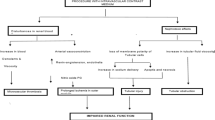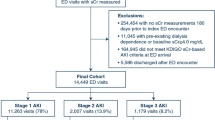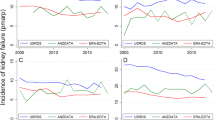Abstract
Background
Renal cyst bleeding is a frequent problem in patients with autosomal dominant polycystic kidney disease (ADPKD). However, information is still limited on its frequency, causative factors, and effects on enlargement of polycystic kidneys in ADPKD.
Methods
We investigated the total volume of acute renal intracystic hemorrhage and its association with total kidney volume (TKV) in a large series of patients with ADPKD on dialysis, referred for renal transcatheter arterial embolization. All patients had undergone CT scan and MRI scan before the procedure. We evaluated factors potentially associated with acute renal intracystic hemorrhage. The association between the volume of acute renal intracystic hemorrhage and the potential predisposing and associated factors was analysed by univariable and multivariable regressions.
Results
We enrolled 199 patients who underwent renal transcatheter arterial embolization from 2014 to 2018 (107 men, 92 women; mean age 59.1 ± 8.6 years). The median volume of acute renal intracystic hemorrhage was 97.3 ml (interquartile range 36.6–261.7 ml). Multivariable analysis revealed that body weight, kidney stones, systolic blood pressure, and total volume of acute renal intracystic hemorrhage were significantly associated with TKV; age, body mass index, smoking, renal cyst infection, serum alkaline phosphatase, and TKV were significantly associated with the volume of acute renal intracystic hemorrhage ; and sex, age, dialysis vintage, TKV, and total volume of acute renal intracystic hemorrhage were significantly associated with the number of microcoils required to achieve renal transcatheter arterial embolization. Total volume of acute renal intracystic hemorrhage was significantly associated with TKV (r = 0.15, p = 0.0325) and was greater in younger patients (r= − 0.32, p < 0.0001). Total volume of acute renal intracystic hemorrhage was also correlated with the number of microcoils required for renal transcatheter arterial embolization (r = 0.23, p = 0.0012).
Conclusion
Acute renal intracystic hemorrhage is frequent among ADPKD patients on dialysis, and total volume of acute renal intracystic hemorrhage significantly associated with TKV. Total volume of acute renal intracystic hemorrhage was greater in younger patients with higher renal artery luminal size. These results suggest that renal cyst bleeding and renal artery blood flow may synergistically accelerate the enlargement of polycystic kidneys in ADPKD patients on dialysis.
Graphical abstract






Similar content being viewed by others
Data availability
Deidentified data are available on reasonable request from the corresponding author.
References
Cornec-Le Gall E, Alam A, Perrone RD (2019) Autosomal dominant polycystic kidney disease. Lancet. https://doi.org/10.1016/S0140-6736(18)32782-X
Ong AC, Devuyst O, Knebelmann B, Walz G, Diseases E-EWGfIK (2015) Autosomal dominant polycystic kidney disease: the changing face of clinical management. Lancet. https://doi.org/10.1016/S0140-6736(15)60907-2
Torres VE, Harris PC, Pirson Y (2007) Autosomal dominant polycystic kidney disease. Lancet. https://doi.org/10.1016/S0140-6736(07)60601-1
Suwabe T, Shukoor S, Chamberlain AM et al (2020) Epidemiology of autosomal dominant polycystic kidney disease in Olmsted county. Clin J Am Soc Nephrol. https://doi.org/10.2215/CJN.05900519
Chow CL, Ong AC (2009) Autosomal dominant polycystic kidney disease. Clin Med (Lond). https://doi.org/10.7861/clinmedicine.9-3-278
Riyahi S, Dev H, Blumenfeld JD et al (2021) Hemorrhagic cysts and other MR biomarkers for predicting renal dysfunction progression in autosomal dominant polycystic kidney disease. J Magn Reson Imaging. https://doi.org/10.1002/jmri.27360
Suwabe T, Ubara Y, Sumida K et al (2012) Clinical features of cyst infection and hemorrhage in ADPKD: new diagnostic criteria. Clin Exp Nephrol. https://doi.org/10.1007/s10157-012-0650-2
Suwabe T, Ubara Y, Ueno T et al (2016) Intracystic magnetic resonance imaging in patients with autosomal dominant polycystic kidney disease: features of severe cyst infection in a case-control study. BMC Nephrol. https://doi.org/10.1186/s12882-016-0381-9
Gaillard F, Jones J (2009) Hemorrhage on MRI. Radiopaedia. https://doi.org/10.53347/rID-6671
Pei Y, Obaji J, Dupuis A et al (2009) Unified criteria for ultrasonographic diagnosis of ADPKD. J Am Soc Nephrol. https://doi.org/10.1681/ASN.2008050507
Gaillard APF (2015) Evolution of CT density of intracranial hemorrhage (diagram). Radiopaedia. https://doi.org/10.53347/rID-36064
Levine E, Grantham JJ (1987) Perinephric hemorrhage in autosomal dominant polycystic kidney disease: CT and MR findings. J Comput Assist Tomogr. https://doi.org/10.1097/00004728-198701000-00021
Ubara Y, Tagami T, Sawa N et al (2002) Renal contraction therapy for enlarged polycystic kidneys by transcatheter arterial embolization in hemodialysis patients. Am J Kidney Dis. https://doi.org/10.1053/ajkd.2002.31407
Suwabe T, Ubara Y, Mise K et al (2016) Suitability of patients with autosomal dominant polycystic kidney disease for renal transcatheter arterial embolization. J Am Soc Nephrol. https://doi.org/10.1681/ASN.2015010067
Masoumi A, Reed-Gitomer B, Kelleher C, Bekheirnia MR, Schrier RW (2008) Developments in the management of autosomal dominant polycystic kidney disease. Ther Clin Risk Manag. https://doi.org/10.2147/tcrm.s1617
Cornec-Le Gall E, Audrezet MP, Rousseau A et al (2016) The PROPKD score: a new algorithm to predict renal survival in autosomal dominant polycystic kidney disease. J Am Soc Nephrol. https://doi.org/10.1681/ASN.2015010016
Arakawa S, Saku Y, Ibayashi S, Nagao T, Fujishima M (1998) Blood pressure control and recurrence of hypertensive brain hemorrhage. Stroke. https://doi.org/10.1161/01.str.29.9.1806
Irie K, Yamaguchi T, Minematsu K, Omae T (1993) The J-curve phenomenon in stroke recurrence. Stroke. https://doi.org/10.1161/01.str.24.12.1844
Passero S, Burgalassi L, D’Andrea P, Battistini N (1995) Recurrence of bleeding in patients with primary intracerebral hemorrhage. Stroke. https://doi.org/10.1161/01.str.26.7.1189
Schrier RW, Abebe KZ, Perrone RD et al (2014) Blood pressure in early autosomal dominant polycystic kidney disease. N Engl J Med. https://doi.org/10.1056/NEJMoa1402685
Torres VE, King BF, Chapman AB et al (2007) Magnetic resonance measurements of renal blood flow and disease progression in autosomal dominant polycystic kidney disease. Clin J Am Soc Nephrol. https://doi.org/10.2215/CJN.00910306
Acknowledgements
Mr. Toshihito Furukawa (Biostatistical Research Co., Ltd. Tokyo, Japan) assisted with the analysis and interpretation of data. This manuscript has been checked by a native English-speaking medical editor, Andrea Baird, MD, from Edanz (https://jp.edanz.com/ac).
Funding
This study was supported by JSPS KAKENHI (Grant Number JP19K17758). This study was also supported in part by a grant from the Japanese Association of Dialysis Physicians (JADP Grant 2018-5), a Grant-in-Aid for Progressive Renal Disease Research from the Ministry of Health, Labour and Welfare of Japan, and by Okinaka Memorial Institute for Medical Research, Toranomon Hospital.
Author information
Authors and Affiliations
Contributions
Research idea and study design: TS, YU, NS; data acquisition: TS, YU, YO, HM, DI, MY, NS; data analysis/interpretation: TS, YU, NS; statistical analysis: TS, YU, NS. Each author contributed important intellectual content during manuscript drafting or revision and accepts accountability for the overall work by ensuring that questions pertaining to the accuracy or integrity of any portion of the work are appropriately investigated and resolved.
Corresponding author
Ethics declarations
Conflict of interest
The authors declare that they have no conflict of interest.
Ethical approval
The study was conducted according to the guidelines of the Declaration of Helsinki. This study was reviewed and approved by the ethics committee of Toranomon Hospital in June 2020.
Additional information
Publisher's Note
Springer Nature remains neutral with regard to jurisdictional claims in published maps and institutional affiliations.
Supplementary Information
Below is the link to the electronic supplementary material.
Rights and permissions
Springer Nature or its licensor (e.g. a society or other partner) holds exclusive rights to this article under a publishing agreement with the author(s) or other rightsholder(s); author self-archiving of the accepted manuscript version of this article is solely governed by the terms of such publishing agreement and applicable law.
About this article
Cite this article
Suwabe, T., Ubara, Y., Oba, Y. et al. Acute renal intracystic hemorrhage in patients with autosomal dominant polycystic kidney disease. J Nephrol 36, 999–1010 (2023). https://doi.org/10.1007/s40620-022-01562-z
Received:
Accepted:
Published:
Issue Date:
DOI: https://doi.org/10.1007/s40620-022-01562-z




